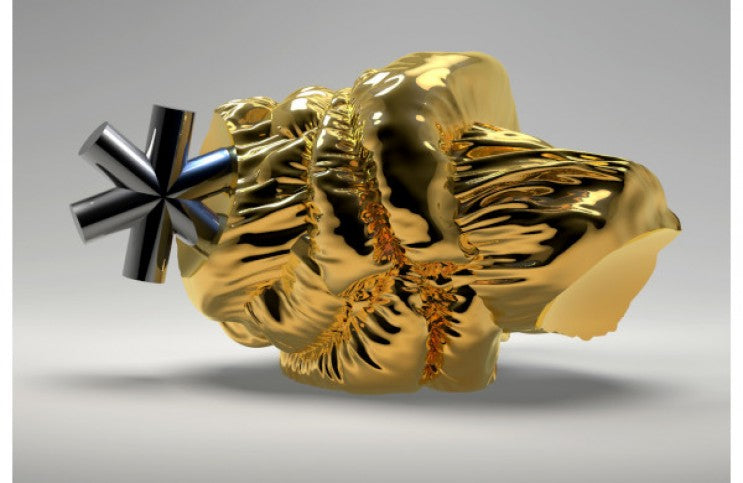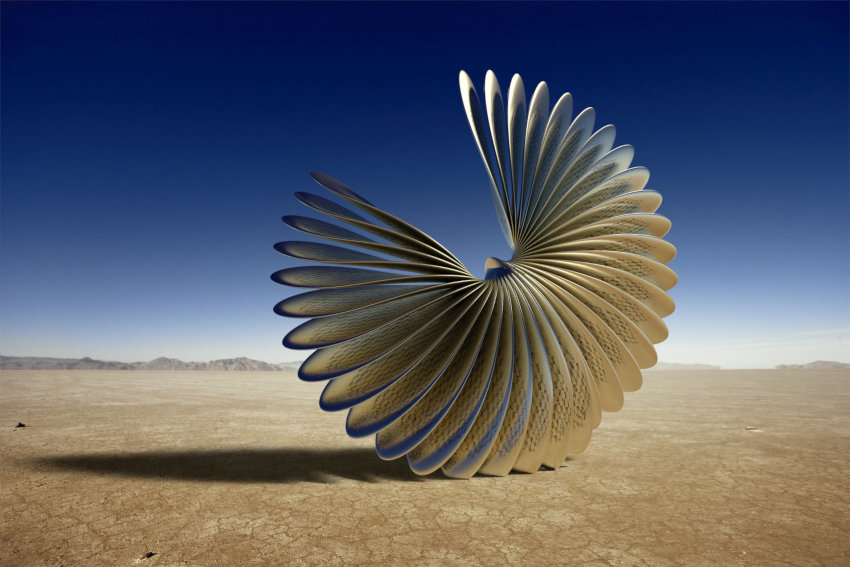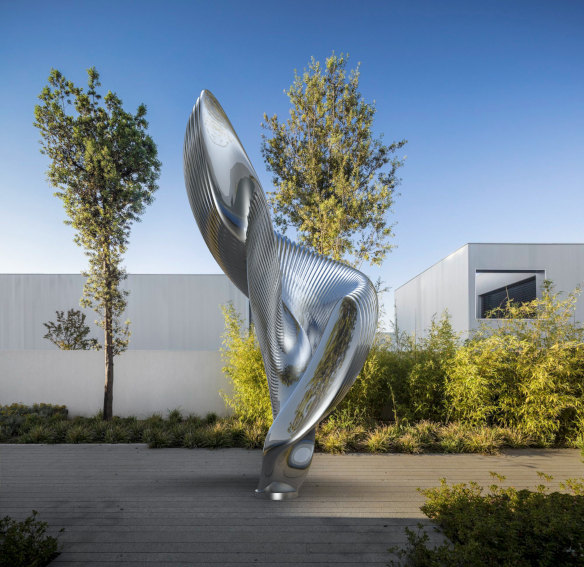
How Ken Kelleher Digitally Reimagines Public Spaces with Abstract Art
Ken Kelleher is one of the most misunderstood artists of our time. Most people who claim to be fans of his work do not even seem to know exactly what it is that he does. Trained as a sculptor at Alfred University in New York, Kelleher earned his technical chops working in a foundry upstate, finishing cast bronze pieces for artists like Anthony Caro and William Tucker. But his true talent is in the realm of digital design, a field in which he worked for 20 years before embarking on his own sculptural practice. A huge part of his current output consists of digital renderings of imaginary, large-scale abstract sculptures, which he then drops into photographs of real-world public spaces. These digital renderings are so hauntingly realistic that you would be forgiven for believing the sculptures actually exist. The vast majority of articles that have been written about Kelleher go so far as to call him a “digital artist” and focus exclusively on his renderings, as though they are the finished artworks. Kelleher, however, bemoans this description. He says, “Some articles have made it sound like the renderings I’m doing are the art, but in actuality, the designs I’m doing are meant to be built.” Kelleher has a large studio on his property where he works with a range of materials, including wood, fiberglass, plastic and steel. He claims to be working with a number of fabricators and public planners to make some of his imaginary creations a reality, but the problem is that most of the forms he imagines are either so monumental, so complex, or both, that fabricating them would require a Herculean effort paired with limitless funds. Despite how awesome the renderings look, the vast majority of his sculptures have not been, and may not ever be, built. Therein his frustration lies. Kelleher wants us to experience the fantastical objects of his imagination, but the human world to which we belong is not quite ready to merge with the post human fantasy from whence they come.
Art Experience vs. User Experience
One barrier that stops some people from understanding what Kelleher does has to do with the question of whether he is an artist or a designer. We can talk about his work using the language of either field. In the language of contemporary art, we might say something like this: Kelleher has a practice that is informed by notions of Post-Modernity, Interdisciplinarity, and Placemaking. His visual language is informed by a blend of multiple Modernist aesthetic positions, including Biomorphism, Abstract Expressionism, Geometric Abstraction, Kinetic Art, and Pop Art. He explores the formal aspects of those positions through a range of materials and methods then deploys his creations in public spaces—either digitally or, ideally, in the real world—where they function as social interventions, transforming public spaces and strengthening the bond between people and their built environment.

Ken Kelleher- Asterix - Studio Size. © 2019 Ken Kelleher Studios
In the language of the contemporary design field, we might describe his work more like this: Kelleher has developed a brand based on mobilizing User Experience (UX) design strategies to expand his public art products from virtual reality (VR) into public, private and corporate spaces in real life (IRL). Most of his products exist only VR, however, in partnership with various specialty fabricators, some of his products can potentially be brought to market IRL. Meanwhile, in collaboration with augmented reality (AR) firms like Look Mister, Kelleher is experimenting with the possibility that various products deemed too monumental, expensive or complex to exist IRL can manifest in public spaces via AR technology, enhancing the UX of users with access to AR technology.

Ken Kelleher- Circle Wing (Tradewinds). © 2019 Ken Kelleher Studios
Post-Human vs. Veryhuman
The difference between describing Kelleher with art language and describing him with design language seems to come down to the level of humanity each of those two vocabularies conveys. Design language feels decidedly Post-Human. It reduces people to “users,” and clarifies separations between those with access to digital technology and those without. When we talk about Kelleher with that vocabulary, or only in terms of his digital designs, we dehumanize his practice, making him out to be a purely Post-Human artist making work only for those who possess the technological savvy to enjoy it. Art language is more hopeful. It might sound a little academic, but it prioritizes the humanity of the work. It talks about the relationships Kelleher is trying to create between people, objects, and the spaces they inhabit. Art vocabulary places Kelleher more in the community of what I call veryhumans—people motivated by human sensibilities, who are striving to create a future that prioritizes humans as part of nature, not as repositories for technology.

Ken Kelleher- Becoming. © 2019 Ken Kelleher Studios
I prefer to imagine Kelleher as a veryhuman artist, working away in his outbuilding like Alexander Calder, surrounded by drawings and models of fantastical artworks that he actually wants to build out of materials like wood, steel and fiberglass. In this scenario there is a computer in the room, but it is only a tool to help him get to the final object—that useless, beautiful, mysterious thing that will inhabit real time and space. Yet, I also understand why Kelleher is being championed by the Post-Humans. They are understandably impressed with his next-level digital design skills. The question is, how does Kelleher really see himself? On his website, he goes out of his way to appeal to visitors to help him turn his imagined works into realities, but then he also goes and posts on social media every time he creates a new digital rendering or VR video. If he truly sympathizes with the veryhuman pastime of making things, perhaps he should reserve more bandwidth for his actual objects; because the farther he goes down the rabbit hole of UX, VR and AR, the more it seems Kelleher is most misunderstood by himself.
Featured image: Ken Kelleher- Aspire. © 2019 Ken Kelleher Studios
All images used for illustrative purposes only
By Phillip Barcio






